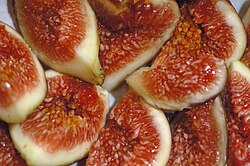Fig Trees in the Rome, Greece and The Bible
Contents
Fig Trees in the Rome, Greece and The Bible
Contributed by: Gaurav Moghe.
Discussed topic: Fig - most frequently referring to the Common Fig (Ficus carica)
Figs have been consumed with relish since ancient times, even by the Romans and Greeks[1]. According to an ancient myth, fig was the favorite fruit of Bacchus, the Lord of Carnival and the Lord of Wine [2]. Fig juices were also used in religious ceremonies. In addition, the fig tree is widely employed in Roman symbolic traditions, as the twin founders of Rome - Romulus and Remus - when they were infants, were transported by the River deity Tiberinus in a basket made from roots of the fig tree. The fig tree, in Rome, was considered an emblem of the future prosperity of the race [3].
The Fig Tree and its fruit, the fig, are mentioned several times in the New Testament as well as the Old Testament. For example, in Genesis 3:7, Adam and Eve cover their nakedness with fig leaves. Figs are ubiquitously found in Israel and in neighboring areas; thus their frequent mention in the Bible. Biblical references to figs are often symbolic and refer to more than just the common Mediterranean fruit tree and the Common Fig. In the Bible, figs are a symbol or type, subject to various interpretations.
Interestingly, in the Old Testament's Book of 2 Kings [4], there are a few lines that hint at the medicinal properties of the fig tree. The most relevant lines have been made bold.
- In those days was Hezekiah sick unto death. And the prophet Isaiah the son of Amoz came to him, and said unto him, Thus saith the LORD, Set thine house in order; for thou shalt die, and not live.
- Then he turned his face to the wall, and prayed unto the LORD, saying,
- I beseech thee, O LORD, remember now how I have walked before thee in truth and with a perfect heart, and have done that which is good in thy sight. And Hezekiah wept sore.
- And it came to pass, afore Isaiah was gone out into the middle court, that the word of the LORD came to him, saying,
- Turn again, and tell Hezekiah the captain of my people, Thus saith the LORD, the God of David thy father, I have heard thy prayer, I have seen thy tears: behold, I will heal thee: on the third day thou shalt go up unto the house of the LORD.
- And I will add unto thy days fifteen years; and I will deliver thee and this city out of the hand of the king of Assyria; and I will defend this city for mine own sake, and for my servant David's sake.
- And Isaiah said, Take a lump of figs. And they took and laid it on the boil, and he recovered.
Recent research has suggested that Figs may have anti-inflammatory properties [5]. Figs are one of the highest plant sources of calcium and fiber. According to USDA data for the Mission variety, dried figs are richest in fiber, copper, manganese, magnesium, potassium, calcium, and vitamin K, relative to human needs. They have smaller amounts of many other nutrients. Figs have a laxative effect and contain many antioxidants. They are good source of flavonoids and polyphenols[6] including gallic acid, chlorogenic acid, syringic acid, (+)-catechin, (−)-epicatechin and rutin.[7]
For more information on cultural importance of figs, refer to this article on Wikipedia: Common_fig#Cultural_aspects
References
- ^ Dormice, sea urchins and fresh figs: the Roman diet revealed Telegraph UK. Published: 14 June, 2011
- ^ Dionysos - the Lord of Carnival Retrieved: August 20, 2011
- ^ Facts about ancient Rome: figs,as discussed in fig (plant and fruit) Encyclopedia Brittanica. Accessed: August 19, 2011
- ^ Book of 2 Kings from The holy Bible, King James version. Electronic Text Center, University of Virginia Library
- ^ Ficus spp. (fig): ethnobotany and potential as anticancer and anti-inflammatory agents Published: 2008 Jun 28
- ^ Vinson (1999)
- ^ Phenolic acids and flavonoids of fig fruit (Ficus carica L.) in the northern Mediterranean region. Robert Veberic, Mateja Colaric and Franci Stampar, Food Chemistry, Volume 106, Issue 1, 1 January 2008, Pages 153-157, doi:10.1016/j.foodchem.2007.05.061
Comments
blog comments powered by DisqusMore notes like this
| |||||||||||||||||||||||||||||||||||||||||||||||||||||||||||||||||||||||||||||||||||||
Only 15 articles are shown in this list. A total of 64 articles in the database as of this moment. For the complete list, click on further results on the bottom right corner of the above table.
Semantic tags
- Browse all Semantic Tags associated with this page
- Find more pages and articles created by the community by clicking this link.
| Title | Fig Trees in the Rome, Greece and The Bible | Article is on this general topic | Mythology and religion | Author | Gaurav Moghe |
|---|---|---|---|---|---|
| Specific location(s) where study was conducted | Not noted | General region where study was conducted | Not noted | State where study was conducted | Pan-India |
| Institutional affiliation | Not noted | Institution located at | Not noted | Institution based around | Not noted |
| Species Group | Not noted | User ID | User:Gauravm | Page creation date | 2011/11/03 |
Share this page:

